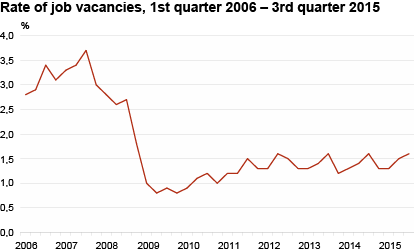In the 3rd quarter, the number of job vacancies increased 3% year over year
The rate of job vacancies, i.e. the share of job vacancies in the total number of jobs, was 1.6% in the 3rd quarter of 2015, remaining the same as in the 3rd quarter of 2014. The rate of job vacancies was the highest in other service activities (3.3%), which include laundries, dry cleaning, beauty services, the repair of computers and personal goods etc. However, in the case of this economic activity, the share of vacant and occupied posts in the total number of posts is 1.0%. The rate of job vacancies was the lowest in three economic activities – agriculture, forestry and fishing, mining and quarrying, and real estate activities (all 0.3%).
The highest share of both vacant and occupied posts in the total number of posts was recorded in manufacturing (19%), wholesale and retail trade (16%), and education (10%).
The rise in the number of job vacancies was the biggest in information and communication, where there were two times more vacancies compared to the 3rd quarter of 2014.
57% of the vacant and occupied posts were in Harju county (including Tallinn), followed by Tartu county (11%) and Ida-Viru county (8%). The rate of job vacancies was the highest in Harju county (including Tallinn) (2.0%) and the lowest in Põlva county (0.7%).
69% of the job vacancies were in the private sector and 31% were in the public sector. The rate of job vacancies was 1.9% in the public sector and 1.5% in the private sector. The public sector includes companies owned by the state or local governments.The movement of labour is characterised by labour turnover (the total of engaged employees and those who have left), which amounted to 77,000 employees in the 2nd quarter of 2015, denoting a decrease of 0.2% compared to the 2nd quarter of 2014, but a 26.6% increase compared to the previous quarter. In the 2nd quarter of 2015, the largest increase in labour turnover compared to the 2nd quarter of 2014 occurred in arts, entertainment and recreation (50%), in accommodation and food service activities (47%) and in information and communication (44%).
The data are based on the job vacancies and labour turnover survey, conducted by Statistics Estonia since 2005. In 2015, the sample includes 12,376 enterprises, institutions and organisations; the data of randomly selected units are imputed to the total population separately in each stratum.
The number of job vacancies is the total number of job vacancies on the 15th day of the second month of the quarter. A job vacancy is a paid post that is newly created, unoccupied or becomes vacant when an employee leaves, and for which the employer is actively trying to find a suitable candidate from outside the enterprise, institution or organisation concerned.
